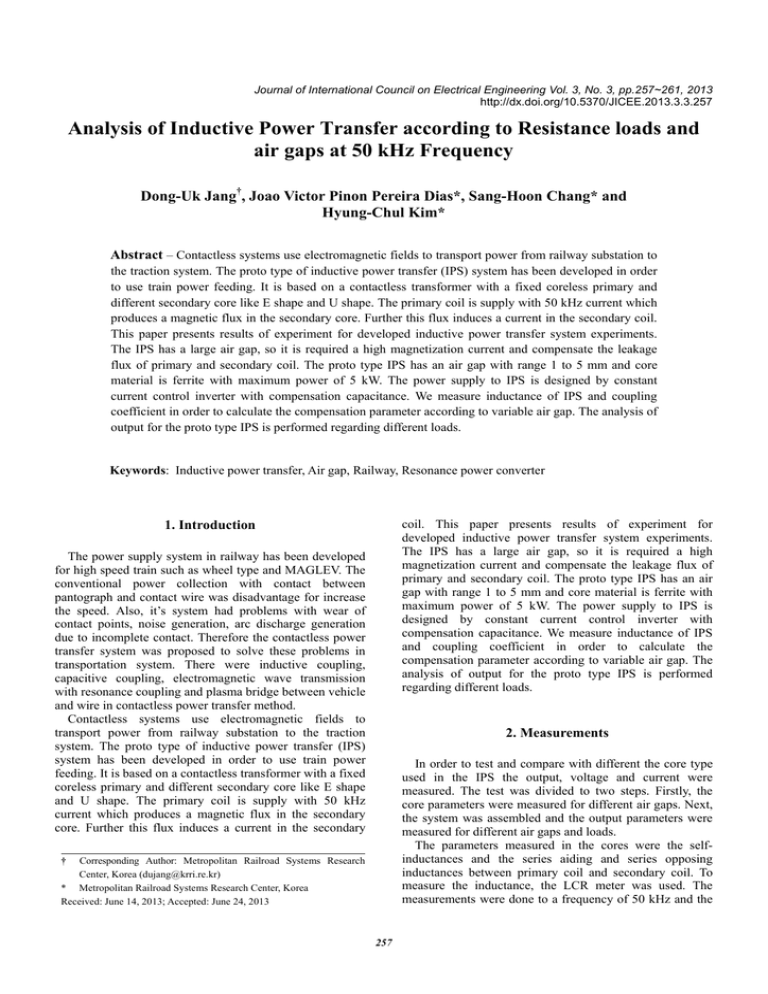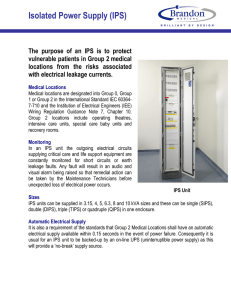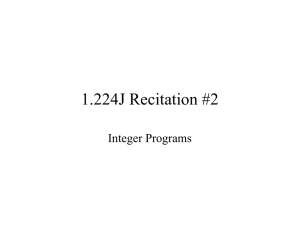Analysis of Inductive Power Transfer according to Resistance loads
advertisement

Journal of International Council on Electrical Engineering Vol. 3, No. 3, pp.257~261, 2013 http://dx.doi.org/10.5370/JICEE.2013.3.3.257 Analysis of Inductive Power Transfer according to Resistance loads and air gaps at 50 kHz Frequency Dong-Uk Jang†, Joao Victor Pinon Pereira Dias*, Sang-Hoon Chang* and Hyung-Chul Kim* Abstract – Contactless systems use electromagnetic fields to transport power from railway substation to the traction system. The proto type of inductive power transfer (IPS) system has been developed in order to use train power feeding. It is based on a contactless transformer with a fixed coreless primary and different secondary core like E shape and U shape. The primary coil is supply with 50 kHz current which produces a magnetic flux in the secondary core. Further this flux induces a current in the secondary coil. This paper presents results of experiment for developed inductive power transfer system experiments. The IPS has a large air gap, so it is required a high magnetization current and compensate the leakage flux of primary and secondary coil. The proto type IPS has an air gap with range 1 to 5 mm and core material is ferrite with maximum power of 5 kW. The power supply to IPS is designed by constant current control inverter with compensation capacitance. We measure inductance of IPS and coupling coefficient in order to calculate the compensation parameter according to variable air gap. The analysis of output for the proto type IPS is performed regarding different loads. Keywords: Inductive power transfer, Air gap, Railway, Resonance power converter coil. This paper presents results of experiment for developed inductive power transfer system experiments. The IPS has a large air gap, so it is required a high magnetization current and compensate the leakage flux of primary and secondary coil. The proto type IPS has an air gap with range 1 to 5 mm and core material is ferrite with maximum power of 5 kW. The power supply to IPS is designed by constant current control inverter with compensation capacitance. We measure inductance of IPS and coupling coefficient in order to calculate the compensation parameter according to variable air gap. The analysis of output for the proto type IPS is performed regarding different loads. 1. Introduction The power supply system in railway has been developed for high speed train such as wheel type and MAGLEV. The conventional power collection with contact between pantograph and contact wire was disadvantage for increase the speed. Also, it’s system had problems with wear of contact points, noise generation, arc discharge generation due to incomplete contact. Therefore the contactless power transfer system was proposed to solve these problems in transportation system. There were inductive coupling, capacitive coupling, electromagnetic wave transmission with resonance coupling and plasma bridge between vehicle and wire in contactless power transfer method. Contactless systems use electromagnetic fields to transport power from railway substation to the traction system. The proto type of inductive power transfer (IPS) system has been developed in order to use train power feeding. It is based on a contactless transformer with a fixed coreless primary and different secondary core like E shape and U shape. The primary coil is supply with 50 kHz current which produces a magnetic flux in the secondary core. Further this flux induces a current in the secondary 2. Measurements In order to test and compare with different the core type used in the IPS the output, voltage and current were measured. The test was divided to two steps. Firstly, the core parameters were measured for different air gaps. Next, the system was assembled and the output parameters were measured for different air gaps and loads. The parameters measured in the cores were the selfinductances and the series aiding and series opposing inductances between primary coil and secondary coil. To measure the inductance, the LCR meter was used. The measurements were done to a frequency of 50 kHz and the † Corresponding Author: Metropolitan Railroad Systems Research Center, Korea (dujang@krri.re.kr) * Metropolitan Railroad Systems Research Center, Korea Received: June 14, 2013; Accepted: June 24, 2013 257 Analysis of Inductive Power Transfer according to Resistance loads and air gaps at 50 kHz Frequency defined as well due to manufacture characteristic of the MOSFET switching device. The maximum output voltage is was limited to 150 V. air gap was increase from 1 mm to 5 mm with 1 mm step. With the measured values the values of mutual inductance (M) and coupling coefficient (k) were calculated as following equations respectively. M = (La − Lb )/4 (1) k = M L1 /L2 (2) Here, La is the inductance of the coils in series-adding mode and Lb is series-opposite mode. L1 and L2 are the primary and secondary self-inductances respectively The measurements were done for the two types of the cores and the results were presented in a previous work of the author [2]. The values of the inductances are reproduced in the table below. Table 1. Measured inductance values Core Distance of Llp [μH] Lm [μH] type air gap E-I 1 mm 0.343 9.731 E-I 3 mm 1.123 4.256 E-I 5 mm 1.456 2.496 U-I 1 mm 1.914 6.2745 U-I 3 mm 1.596 4.683 U-I 5 mm 1.819 2.980 Fig. 1. The experimental system. The cores were tested for 3 different air gap sizes, 1, 3, and 5 mm. The high power resistance has two possible connections configurations, allowing utilization of two different resistance values, 3 and 6 Lms [μH] 0.431 1.865 2.810 2.033 1.800 2.167 With the values of the inductances the value of the equivalent inductance was calculated for each one of the values of the air gap size. The equivalent inductance was calculated from inductance of Table 1. The next step was determining the value of the compensation capacitance. The values are presented in table 2. Table 2 Compensation capacitance values Distance of Compensation capacitance Core type air gap [μF] E-I 1 mm 13.758 E-I 3 mm 4.186 E-I 5 mm 3.648 U-I 1 mm 2.937 U-I 3 mm 3.499 U-I 5 mm 3.296 Fig. 2. Waveforms E-I core at 5mm and 3 Ohm. The IPS circuit was mounted with the compensation values showed in table 2 for each one of the air gaps. Following the scheme presented in Fig. 1 the IPS was mounted. The switching frequency of the inverter was 50 kHz. To be able to compare the results of the both cores was decided to fix the output current of the inverter using the DSP program. The output current of inverter (primary input current) was set to 50 A. The maximum output voltage had to be Fig. 3. Waveforms E-I core at 5mm and 6 Ohm. The measurements were performed with oscilloscope DL850 made by YOKOGAWA, the RMS value of the current and voltage of the input, output of the contactless 258 Dong-Uk Jang, Joao Victor Pinon Pereira Dias, Sang-Hoon Chang and Hyung-Chul Kim transformer and the average value of the DC current and voltage of the load were measured. The Figs below exemplify the wave forms measured. The results were gathered in an electronic table and the graphs with the results are presented in the next section. resistance. Fig. 7. Primary values vs. air gap with 6[Ω] of load resistance. Fig. 4. Waveforms U-I core at 5mm and 3 Ohm. Fig. 8. Secondary values vs. air gap with 3[Ω] of load resistance. Fig. 5. Waveforms U-I core at 5mm and 6 Ohm. 3. Results and Discuss The measurements of the currents and voltage for the different air gaps and loads in the prototype are presented in the graphs below. Fig. 9. Secondary values of vs. air gap with 6[Ω] of load resistance. To analyze the results the discussion will be divided the results in three topics: input, output and load. The analysis will focus the comparison of the two cores, and how the load and the air gap size influence the results. The input values presented in Figs 6 and 7 show the operation boundaries defined. The current is maintained Fig. 6. Primary values vs. air gap with 3[Ω] of load 259 Analysis of Inductive Power Transfer according to Resistance loads and air gaps at 50 kHz Frequency steady near the rated value, 50A. The inverter works as a current source so the voltage levels change to maintain the rated value for the change of air gap and load. The E-I core has a smaller voltage then the U-I core, moreover less power should be supplied to ensure the rated voltage in the input of the contactless transformer. The change of the load increase the voltage as expected and the current maintain the same value, due to operation interests. As the air gap increases the voltage decreases. The output showed in Figs 8 and 9 presents again a U-I core with bigger values of voltage in comparison with the E-I core for an air gap of 1 mm, however for the other values of the air gap size the E-I have a bigger value. The currents have similar value for the both core types. With the change in the load the voltage increases as in the input, although the input the current decrease, respecting the Ohm’s Law. 4. Conclusions The proto type IPS has an air gap with range 1 to 5 mm and core material is ferrite with maximum power of 5 kW. The power supply to IPS is designed by constant current control inverter with compensation capacitance. We measure inductance of IPS and coupling coefficient in order to calculate the compensation parameter according to variable air gap. The analysis of output for the proto type IPS is performed regarding different loads. From results we obtain that the cores supply similar currents to the load moreover the voltage levels change according to the value of the air gap. The changes in the load value produce same response for the different cores. References [1] J. V. P. P. Dias, H. Kim and D Jang, “Computer Model for Railway Inductive Power Supply Using the Valtchev Model”, ICEMS 2011: International Conference on Electrical Machines and Systems, 20-23 August, Beijing, China. [2] D. Jang, J. V. P. P. Dias, H. Kim, D. Lee and S. Jung, “The Characteristics Analysis and Design for 5kW Contactless Transformer”, 2011 Autumn Conference & Annual Meeting of the Korean Society for Railway, 2022 October , Jeju, South Korea2011. [3] M. Bauer, P. Becker and Q. Zhengl, “Inductive Power Supply (IPS®) for the Transrapid”, MAGLEV 2006: The 19th International Conference on Magnetically Levitated Systems and Linear Drives, 13-15 September 2006, Dresden, Germany. [4] Dongsu Lee , Dong-Uk Jang , Hyung-Chul Kim , and Sang-Yong Jung, “Numerical Analysis and Design of Moving Contactless High Power Transformer”, Journal of Magnetics 16(4), December 2011. Fig. 10. DC output values vs. air gap with 3[Ω] of load resistance. Donguk Jang received his B.S degree and M.S degree in electrical engineering from Chungbuk National University. His research interests include power supply systems, high voltage engineering and insulation diagnosis for railway systems. Fig. 11. DC output values vs. air gap with 6[Ω] of load resistance. Lastly, the Figs 10 and 11 represent the measurements in the load. Being DC values the results are similar to the output of the contactless transformer reducing the converter voltage and small losses. 260 Dong-Uk Jang, Joao Victor Pinon Pereira Dias, Sang-Hoon Chang and Hyung-Chul Kim Joao Victor Pinon Pereira Dias received his B.S degree in electrical engineering from State University of Campinas, Brazil in 2008 and his M.S degree from University of Science & Technology, KRRI Campus, Korea. His research interests are Electric Traction systems and Transformers for Railway applications. Sang-Hoon Chang received his M.S and Ph.D degree in department of electrical engineering from Yonsei university and Hongik university respectively in Korea. He had worked at Korea Railroad Corporation since 1982 as a power system research engineer for electric railroad from 1982 to 1994. He has been working for Korea Railroad Research Institute in Korea since 1994. His special fields of interests include power supply system design and analysis for electric railway system. Hyungchul Kim received the B.S. and M.S. degrees in electrical engineering from Korea University, Seoul, Korea, in 1991 and 1993, respectively, and his Ph.D. degree from Texas A&M University, College Station, USA in 2003. He is presently working for Korea Railroad Research Institute, Korea. 261



